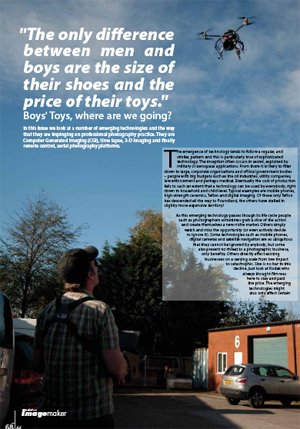articles/Equipment/boys-page1
Boys' Toys, where are we going? - part 1 of 1 2 3 4 5 6 7
by Mike McNamee Published 01/12/2012

The emergence of technology tends to follow a regular, and similar, pattern and this is particularly true of sophisticated technology. The inception often occurs in secret, exploited by military or aerospace applications. From there it is likely to filter down to large, corporate organisations and official government bodies - people with big budgets such as the oil industries, utility companies, law enforcement and perhaps medical. Eventually the cost of production falls to such an extent that a technology can be used by everybody, right down to household and child level. Typical examples are mobile phones, high-strength ceramics, Teflon and digital imaging. Of these only Teflon has descended all the way to Poundland, the others have stalled in slightly more expensive territory!
As this emerging technology passes though its life cycle people such as photographers sometimes grab a slice of the action and create themselves a new niche market. Others simply watch and miss the opportunity (or even actively decide to ignore it). Some technologies such as mobile phones, digital cameras and satellite navigation are so ubiquitous that they cannot be ignored by anybody, but some also present no threat to a photographic business, only benefits. Others directly affect existing businesses on a varying scale from low impact to catastrophic. Size is no bar to this decline, just look at Kodak who always thought film was here to stay and paid the price. The emerging technologies might also only affect certain sectors of the photographic trade. Mobile cameras might cause the decline of a small number of print sales from a wedding but people are yet to photograph weddings exclusively on a mobile (as far as we know!).
The effect of our first topic, CGI is much more complex and has arguably caused the decline of some activities but opened opportunities for others.
If you need a marker on the way that new technology penetrates a market look at the video posted by Martyn Ashton which 'went viral', featured on national TV, and presently has recorded just short of six million hits.

The five-minute feature of Ashton doing crazy things on a bicycle seems to have been shot on a variety of media but includes the latest 'GoPro' techniques of attaching small cameras to the people and equipment used in extreme sports (see http://www.youtube.com/watch?v=7ZmJtYaUTa0).
Think about it; how else could you persuade six million people to watch every second of your five-minute 'advert' for a bike; it is the kind of coverage ad agencies would die for. If you were the content creator of such a sensation, somebody in that six million is likely to want to talk business with you, it beats the hell out of a leaflet drop!
CGI and Photography
Computer Generated Images (CGI) are an offshoot from the engineering industry which initially started to employ computers for the creation and storage of engineering drawing - more commonly known as blue-prints in their day because the diazo process employed could not make a real black tone. As computers in engineering became more common, 'plotters' were developed and these were the forerunners of today's inkjet printers.
The need for prints of engineering drawings was straightforward: an approved 'master' was kept in a central location and prints were supplied, on-demand, to go down to the shop floor for manufacture of whatever was on the drawing. Modifications to a master required many hoops to be jumped through and officially signed off. The whole operation was quite vast with staffing levels from one, to as many as 20, depending upon the organisation. With the blueprint machine being centralised, it was usually the apprentice's job to go and collect the prints. The whole operation had both upsides and downsides. The print room dragons could hold the production staff to ransom (and often did!), the upside, as an apprentice, was that as long as you had a roll of prints under your arm you could wander the site at will - in your editor's case, one end of the factory housed 5,000 women, which from today's perspective might seem like a dream but at the time was a terrifying place!
You are currently on page 1
- Boys' Toys, where are we going? page 1
- Boys' Toys, where are we going? page 2
- Boys' Toys, where are we going? page 3
- Boys' Toys, where are we going? page 4
- Boys' Toys, where are we going? page 5
- Boys' Toys, where are we going? page 6
- Boys' Toys, where are we going? page 7
1st Published 01/12/2012
last update 21/07/2022 08:46:23
More Equipment Articles
There are 20 days to get ready for The Society of Photographers Convention and Trade Show at The Novotel London West, Hammersmith ...
which starts on Wednesday 14th January 2026










